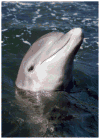Inaugurating the Study of Animal Metacognition
Abstract
Metacognition-the ability to monitor and control one's own cognition-is a sophisticated ability that reveals humans' reflective mind and consciousness. Researchers have begun to explore whether animals share humans' metacognitive capacity. This article reprises the original study that explored metacognition across species. A captive dolphin performed an auditory pitch-discrimination task using High/Low discrimination responses and an Uncertainty response with which he could decline to complete any trials he chose. He selectively declined the difficult trials near his discriminative threshold-just as humans do. This comparative exploration of metacognition required a trial-intensive titration of perceptual threshold and the training of a distinctive behavioral response. It could not have been conducted in the wild, though the naturalistic observation of dolphin uncertainty behaviors and risk-management strategies would no doubt yield complementary insights. The dolphin study inaugurated a new area of cross-species research. This research area opens a new window on reflective mind in animals, illuminates the phylogenetic emergence of metacognition, and may reveal the antecedents of human consciousness.
Keywords: comparative psychology; decision making under uncertainty; dolphin cognition; metacognition; uncertainty monitoring.
Figures




Similar articles
-
The comparative psychology of uncertainty monitoring and metacognition.Behav Brain Sci. 2003 Jun;26(3):317-39; discussion 340-73. doi: 10.1017/s0140525x03000086. Behav Brain Sci. 2003. PMID: 14968691
-
The study of animal metacognition.Trends Cogn Sci. 2009 Sep;13(9):389-96. doi: 10.1016/j.tics.2009.06.009. Epub 2009 Aug 31. Trends Cogn Sci. 2009. PMID: 19726218 Review.
-
Rats show adaptive choice in a metacognitive task with high uncertainty.J Exp Psychol Anim Learn Cogn. 2017 Jan;43(1):109-118. doi: 10.1037/xan0000130. J Exp Psychol Anim Learn Cogn. 2017. PMID: 28045298
-
An assessment of domain-general metacognitive responding in rhesus monkeys.Behav Processes. 2017 Feb;135:132-144. doi: 10.1016/j.beproc.2016.12.004. Epub 2016 Dec 8. Behav Processes. 2017. PMID: 27939856 Free PMC article.
-
Animal metacognition: a tale of two comparative psychologies.J Comp Psychol. 2014 May;128(2):115-31. doi: 10.1037/a0033105. Epub 2013 Aug 19. J Comp Psychol. 2014. PMID: 23957740 Free PMC article. Review.
Cited by
-
Learning to localize sounds in a highly reverberant environment: Machine-learning tracking of dolphin whistle-like sounds in a pool.PLoS One. 2020 Jun 25;15(6):e0235155. doi: 10.1371/journal.pone.0235155. eCollection 2020. PLoS One. 2020. PMID: 32584861 Free PMC article.
-
Human brain organoid code of conduct.Front Mol Med. 2023 Mar 23;3:1143298. doi: 10.3389/fmmed.2023.1143298. eCollection 2023. Front Mol Med. 2023. PMID: 39086687 Free PMC article.
-
Consciousness in dolphins? A review of recent evidence.J Comp Physiol A Neuroethol Sens Neural Behav Physiol. 2013 Jun;199(6):565-82. doi: 10.1007/s00359-013-0816-8. Epub 2013 May 7. J Comp Physiol A Neuroethol Sens Neural Behav Physiol. 2013. PMID: 23649907 Review.
References
-
- Angell F. On judgments of “like” in discrimination experiments. American Journal of Psychology. 1907;18:253.
-
- Atkinson RC, Juola JF. Search and decision processes in recognition memory. In: Krantz DH, Atkinson RC, Luce RD, Suppes P, editors. Learning, Memory, and Thinking. San Francisco, CA: W. H. Freeman; 1974. pp. 243–293.
-
- Au WW, Moore PW. Critical ratio and critical bandwidth for the Atlantic bottlenose dolphin. Journal of the Acoustical Society of America. 1990;88:1635–1638. - PubMed
-
- Benjamin AS, Bjork RA, Schwartz BL. The mismeasure of memory: When retrieval fluency is misleading as a metacognitive index. Journal of Experimental Psychology: General. 1998;127:55–68. - PubMed
